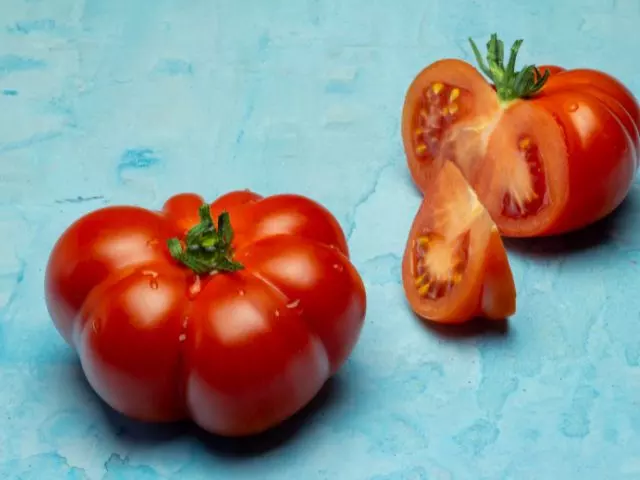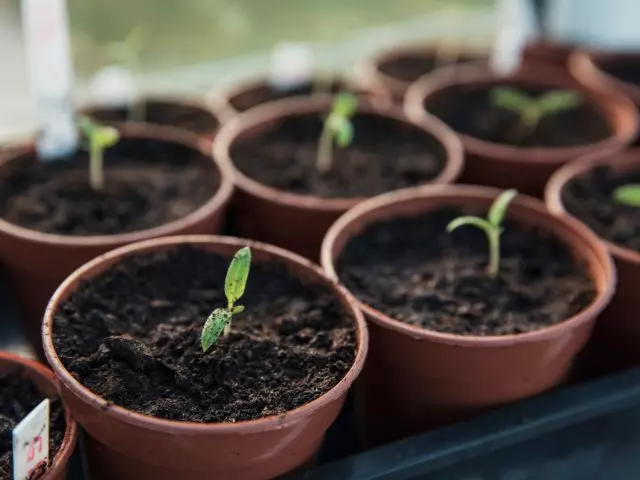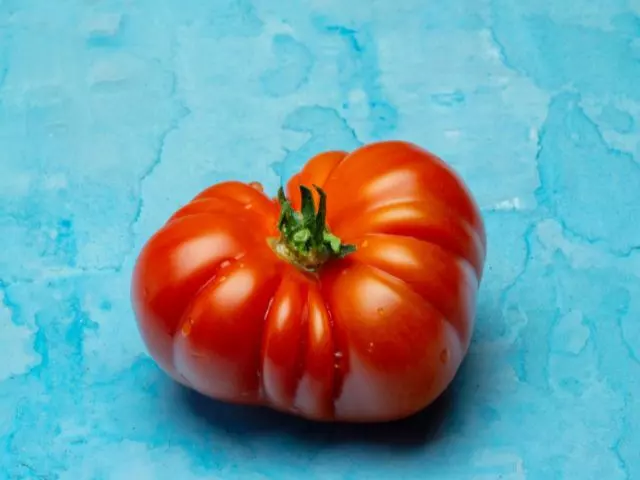Brandywine tomato is one of the best-known and most widely grown tomatoes, its pinkish-red fruits have a perfect balance of sweetness and acidity. Continue reading to learn how to grow Brandywine tomatoes in containers.
Its origin is uncertain, it bears the name of Brandywine Creek in Chester County, Pennsylvania and some say that the Amish were the first to cultivate this tomato, the latter is not very clear… the first reliable reference is that Burpee included it in his catalog as early as 1886.
The quality of Brandywine tomatoes is incomparable, it is considered one of the best tomatoes both for its flavor and texture, its production is relatively high considering that it is an heirloom variety (we do not intend here to compare it with any hybrid) and it keeps quite well.
Table of Contents
Characteristics of Brandywine Tomatoes
Brandywine tomatoes are not at all difficult to grow but before growing Brandywine tomatoes in containers you must consider the characteristics and requirements that this variety of tomatoes needs to grow and develop properly. In the following table, you will find important information about Brandywine tomatoes.
| USDA growing zones | 3 to 11 |
| Fruit yielding | Indeterminate |
| Fruit color | Yellow, orange, red, and pink cultivars are available |
| Fruit flavor | Meaty, low-acidity, juicy |
| Fruit weight | 1 – 1.5 lbs (450 to 680 grams) |
| Plant height | 8–10 feet (2.4 to 3 meters) |
| Days to maturity | 90 – 100 days |
| Soil pH Req | 6.5 to 7 |
| Sun Req | At least 8 hours per day |

Requirements For Growing Brandywine Tomatoes in Containers
Before I start explaining how to grow Brandywine tomatoes in containers I will explain step by step the requirements of soil, sun, watering, and much more that you will need to have to obtain an abundant harvest.
Make sure that where you place the container to grow Brandywine tomatoes receives at least 8 to 10 hours of direct sunlight. Tomato plants need many hours of direct sunlight for their fruits to grow and develop properly.
To grow Brandywine tomatoes in containers, select a container at least 18” (45 cm) in diameter. The larger the container the better the tomato plants will thrive. Make sure the container has drainage holes to prevent tomato roots from rotting due to poor drainage.
Finally, use a substrate rich in organic matter and with good drainage. Brandywine tomatoes need a substrate with a pH between 6.5 and 7. I recommend you read our article about how to measure soil pH.
Provided the above requirements of sun, substrate, and container are met, Brandywine tomatoes will grow well. Keep reading to learn how to grow Brandywine tomatoes in containers.
- Origin: USA. Type: Beefsteak. The Brandywine is considered by many gardeners to be the best-tasting tomato available. I have to agree, although the yellow version is my personal favorite. This “potato leaf” variety is an old Amish heirloom dating back to the mid 1800’s. Beautiful, smooth pink fruit weighing up to 1½ pounds. Purported to have originated in Ohio, from Indiana and Pennsylvania roots. Indeterminate, Open-Pollinated, 80 days from transplant.
How to Grow Brandywine Tomatoes in Containers
A few weeks before the last frost start sowing your Brandywine tomato seeds indoors. You can sow the seeds in seedbeds or directly into the container you will be using. Use quality seeds to ensure successful germination. I prefer to start in seedlings and then repot the Brandywine tomato seedling into the container I will use to grow it.
As mentioned above, use a container at least 18” (45 cm) in diameter and make sure it has sufficient drainage holes to avoid root disease in the tomato plants. You can also use growing bags if desired. It is essential to use a substrate with good drainage and rich in organic matter.
Place the container in an area where it receives at least 8 hours of direct sunlight. Tomato plants need a lot of hours of sun to develop properly. The more hours of sunlight the tomato plants receive, the better for fruit development.
Tomato plants in containers need to be watered more constantly because water evaporates faster. Use mulch over the substrate to promote moisture retention and prevent weed growth. Never overwater, keep moist but not waterlogged.
Similar to other tomato varieties, Brandywine tomatoes will need support structures such as stakes, trellises, tomato cages, or large hoops to keep the plants upright. Once the plant is established, apply a 0-10-10 fertilizer, without nitrogen, so that the plant can focus on fruit production. Learn more about fish fertilizer for plants.
Brandywine tomatoes are typically ready to harvest 90–100 days after planting. It is important to harvest Brandywine tomatoes when they are fully ripe for the best flavor and texture. Never pull the tomatoes from the plant to avoid damaging them, use disinfected scissors or knives.

Diseases and Pests in Brandywine Tomatoes
As tomato plants take time to grow and develop, certain pests and diseases may appear during the plant’s growth. Here are some common diseases and pests that can affect Brandywine tomatoes:
Early blight: This fungal disease can cause brown spots on the leaves and stems of the plant. It can be treated with fungicides or prevented by planting in well-drained soil and spacing plants properly. An article from the University of Minnesota shows how to identify early blight.
Verticillium wilt: This soil-borne disease can cause leaves to wilt and turn yellow, eventually killing the plant. There is no cure, but it can be prevented by rotating crops and planting in well-drained soil.
Fusarium wilt: This fungal disease can cause leaves to yellow and wilt, eventually killing the plant. There is no cure, but it can be prevented by planting disease-resistant varieties and practicing good sanitation.
Tomato hornworm: This large green caterpillar can quickly defoliate a tomato plant. Handpicking and using biological controls like Bacillus thuringiensis can help control them.
Aphids: These small, soft-bodied insects can suck the sap from the leaves and stems of the plant. They can be controlled with insecticidal soap or by introducing beneficial insects like ladybugs. I recommend you to read our article about ladybugs in the garden.
Regular monitoring and timely action can help prevent and control diseases and pests in Brandywine tomatoes. I recommend you read our article on how to use neem oil on tomato plants.
What to Plant with Brandywine Tomatoes: Best and Worst Companion Plants
| Best Companions | Benefits | Worst Companions | Issues |
| Basil | Enhances flavor and repels pests | Cabbage family | Stunts tomato growth |
| Thyme | Attracts beneficial insects and improves flavor | Fennel | Inhibits tomato growth |
| Parsley | Attracts predatory insects and improves flavor | Potatoes | Both can get blight |
| Chives | Repels pests and improves flavor | ||
| Cilantro | Attracts beneficial insects and improves flavor | ||
| Marigolds | Repels nematodes and other pests | ||
| Petunias | Deters certain pests and adds color | ||
| Nasturtiums | Repels aphids and attracts predatory insects | ||
| Zinnias | Attracts pollinators and adds color | ||
| Calendula | Deters pests and promotes healthy growth | ||
| Carrots | Breaks up soil and provides ground cover | ||
| Peppers | Deter some pests and improve flavor | ||
| Asparagus | Acts as a natural pest deterrent | ||
| Radishes | Deter certain pests and improve soil structure | ||
| Cucumbers | Improve flavor and repel pests |
For a detailed insight into which plants to pair with your tomatoes, I highly recommend exploring our article Tomato Companion Plants for Beginners.
When and How to Harvest Brandywine Tomatoes in Containers?
Normally after 90 to 100 days, you will be able to harvest your Brandywine tomatoes. Note the color and brightness of the tomatoes. The ready-to-harvest tomato will be shiny and firm to the touch. Allowing it to mature too long on the plant may cause it to bruise.
Do not pull the tomatoes off the plant as this may damage the plant. Use a disinfected knife or scissors and cut the stem. Not all tomatoes will ripen at the same time, so observe the plant daily when you first start harvesting.

Final Conclusions
Growing Brandywine heirloom tomatoes in containers are possible. If you don’t have space to grow tomatoes in your garden don’t worry and grow them in a container in which you will get the same results. Periodically check the moisture of the substrate because tomatoes in containers need more water.
I hope this article about how to grow Brandywine tomatoes in containers will be useful and in a short time you will have an abundant harvest of these tasty tomatoes. If you have any questions, please do not hesitate to contact us through the contact form, and we will be glad to help you.

